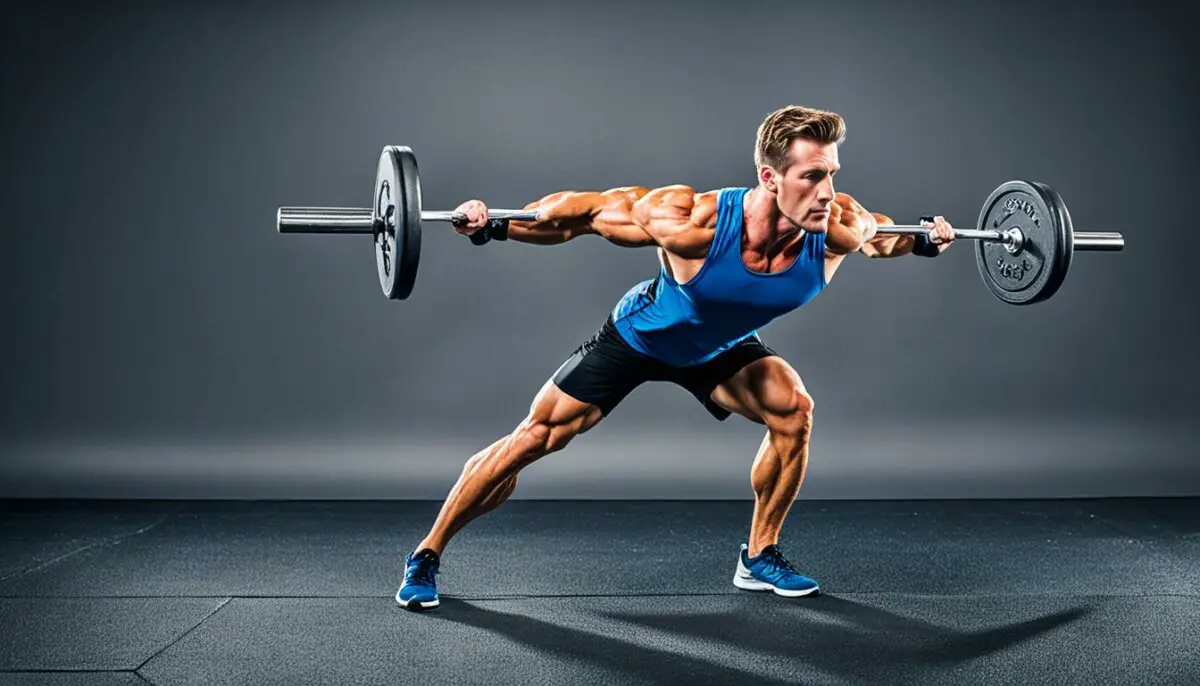Last Updated on 3 months by Francis
The bar reverse lunge is a highly effective exercise for improving leg strength, stability, and power. Whether you’re an athlete looking to enhance your performance or a fitness enthusiast wanting to strengthen your lower body, mastering the bar reverse lunge can take your workouts to the next level.
Also known as the reverse lunge or barbell reverse lunge, this exercise targets key muscle groups such as the quadriceps, hamstrings, glutes, and calves. It strengthens these muscles while improving core stability, hip mobility, and balance.
Contents
Key Takeaways:
- The bar reverse lunge is a highly effective exercise for leg strength and stability.
- It targets muscles such as the quadriceps, hamstrings, glutes, and calves.
- The exercise improves core stability, hip mobility, and balance.
- Proper form and technique are essential to maximize the benefits of the bar reverse lunge.
- Progressions and variations can add variety and challenge to your workout routine.
Benefits of the Bar Reverse Lunge
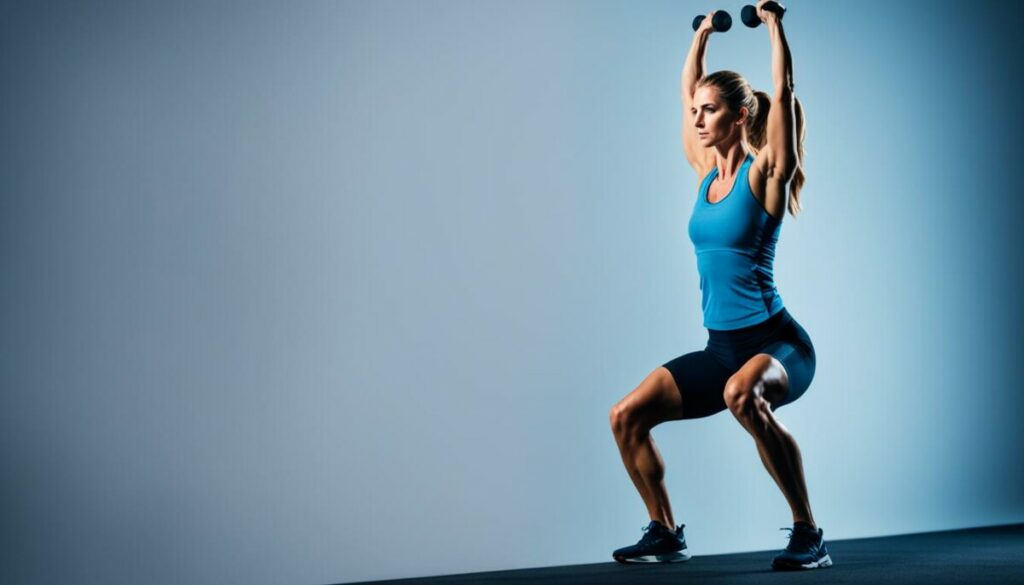
The bar reverse lunge offers a multitude of benefits for the lower body, providing a comprehensive workout for key muscle groups. By incorporating this exercise into your routine, you can enhance leg strength, improve stability, and develop power in targeted muscle groups.
Enhanced Muscle Strength
The bar reverse lunge primarily targets the quadriceps, hamstrings, glutes, and calves. As you lower your body towards the ground, these muscles engage to control the descent and propel you upward. This exercise helps to strengthen and tone these large muscle groups, contributing to improved overall leg strength and stability.
Improved Core Stability
In addition to strengthening the lower body, the bar reverse lunge also enhances core stability. As you perform the exercise, your core muscles engage to maintain balance and control throughout the movement. With consistent practice, this exercise can help improve core strength and stability, which is crucial for maintaining proper form in other exercises and everyday activities.
Increased Hip Mobility
The bar reverse lunge requires hip flexibility and mobility as you step back into the lunge position. By consistently performing this exercise, you can improve hip mobility over time, leading to increased range of motion and better overall movement efficiency. Improved hip mobility can have a positive impact on various athletic activities and everyday movements.
Enhanced Balance and Proprioception
The bar reverse lunge challenges your balance and proprioception, which refers to your body’s awareness of its position in space. As you perform the exercise, you must maintain stability and control, activating the muscles responsible for balance. By consistently incorporating bar reverse lunges into your routine, you can improve your balance and proprioception, which can have a positive impact on athletic performance and overall body awareness.
Functional Exercise with Sports-Specific Benefits
The bar reverse lunge is a functional exercise that translates well to sports performance. By targeting multiple muscle groups simultaneously, it helps improve running speed, agility, and explosive movements. The exercise mimics common movements like cutting, changing directions, and accelerating, making it highly beneficial for athletes in various sports.
Complete Leg Workout
By targeting the quadriceps, hamstrings, glutes, calves, and core muscles, the bar reverse lunge provides a comprehensive leg workout. It engages multiple muscle groups simultaneously, promoting overall leg strength, power, and stability. This exercise can have a positive impact on your performance in various physical activities, from sports to daily tasks.
| Muscle Groups Targeted |
|---|
| Quadriceps |
| Hamstrings |
| Glutes |
| Calves |
| Core Muscles |
Proper Form for Bar Reverse Lunge
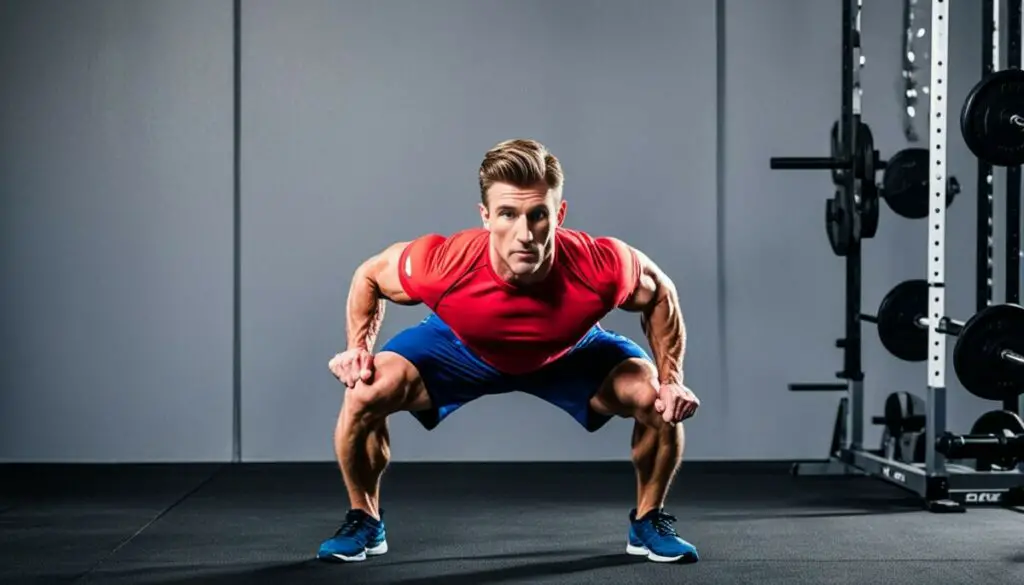
Mastering the proper form for the bar reverse lunge is crucial to maximize its effectiveness and ensure safety during the exercise. Follow these steps to perform the bar reverse lunge with the correct technique:
- Start by standing tall with your feet hip-width apart.
- Hold a barbell across your upper back, gripping it with a wide grip.
- Take a step backward with one leg, bending both knees to lower your body toward the ground.
- Keep your torso upright, engage your core, and lift your chest throughout the movement.
- Once your back knee is almost touching the ground, push through the front foot to return to the starting position.
- Repeat the exercise on the other leg.
When performing the bar reverse lunge, it’s essential to focus on maintaining good posture, distributing the weight evenly between both legs, and controlling the movement. This ensures proper engagement of the targeted muscles and reduces the risk of injury.
Here is a visual representation of the proper form for the bar reverse lunge:
| Steps | Description |
|---|---|
| 1 | Stand tall with feet hip-width apart. |
| 2 | Hold a barbell across your upper back with a wide grip. |
| 3 | Take a step backward with one leg, bending both knees. |
| 4 | Keep your torso upright, engage your core, and lift your chest. |
| 5 | Lower your body until your back knee is near the ground. |
| 6 | Push through the front foot to return to the starting position. |
| 7 | Repeat on the other leg. |
By following these guidelines, you can perform the bar reverse lunge with the proper form and reap its full benefits. Remember to listen to your body, start with lighter weights or just bodyweight if you’re a beginner, and gradually increase the intensity as you become more comfortable and proficient in the exercise.
Variations of Bar Reverse Lunge
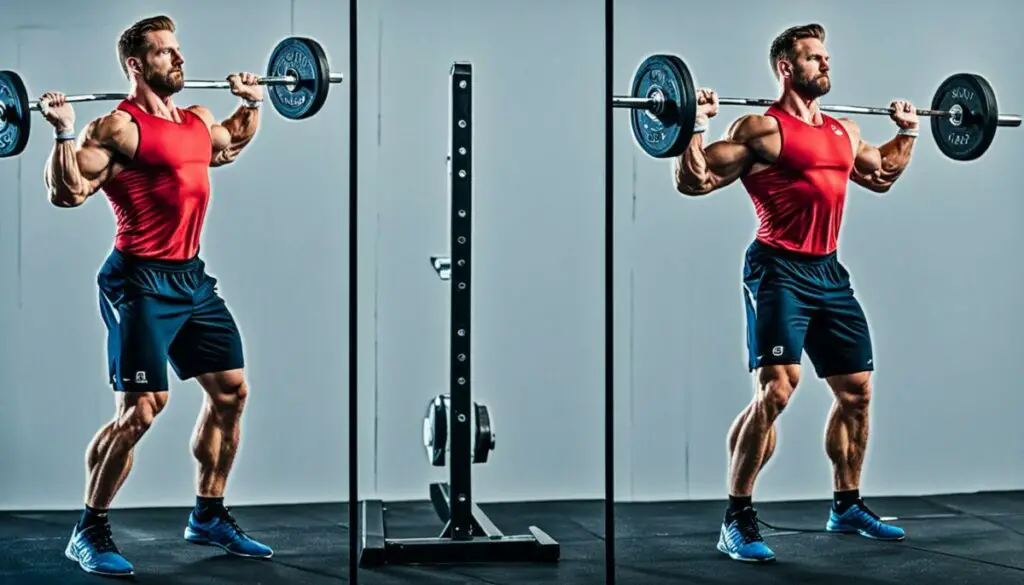
Looking to add some variety and challenge to your workout routine? Try incorporating different variations of the bar reverse lunge. These variations target different muscle groups and add complexity to the exercise, helping you maximize your leg strength gains. Here are a few popular variations to consider:
- Walking Bar Reverse Lunge: Instead of stepping backward, take a step forward with each lunge. This variation engages your leg muscles in a different way and challenges your balance and coordination.
- Barbell Front Reverse Lunge: Hold the barbell in front of your body, resting it on your shoulders or in a racked position. This variation places more emphasis on your quads and challenges your core stability.
- Bulgarian Split Squat: Elevate one foot on a bench or platform behind you and perform the reverse lunge. This variation helps improve single-leg stability, targets your glutes, and requires greater balance and control.
By incorporating these variations into your training routine, you can keep your workouts fresh, challenge your muscles in different ways, and continue to progress towards your fitness goals.
Image Caption: A visual representation of different variations of the bar reverse lunge.
Tips for Implementing Variations
If you’re new to these variations, start with lighter weights or bodyweight exercises to familiarize yourself with the movement patterns and ensure proper form. Gradually increase the intensity and resistance as you build strength and confidence.
Remember, it’s important to maintain proper form and technique throughout each variation. Engage your core, keep your chest lifted, and ensure your knees are aligned with your toes to reduce the risk of injury.
| Variation | Main Muscle Groups Targeted | Difficulty Level |
|---|---|---|
| Walking Bar Reverse Lunge | Quadriceps, Hamstrings, Glutes, Calves | Intermediate |
| Barbell Front Reverse Lunge | Quadriceps, Glutes, Core | Intermediate |
| Bulgarian Split Squat | Glutes, Hamstrings, Quadriceps, Calves | Advanced |
Progressions and Coaching Tips for Bar Reverse Lunge

When starting with the bar reverse lunge, it is essential to focus on establishing a strong foundation and perfecting the movement. Here are some progressions and coaching tips to help you master this exercise:
1. Start with Bodyweight Reverse Lunges
Begin by performing bodyweight reverse lunges to familiarize yourself with the movement pattern. Stand tall with your feet hip-width apart. Take a step backward with one leg and lower your body by bending both knees. Keep your torso upright and core engaged. Push through the front foot to return to the starting position. Repeat on the other leg. Aim for proper form and control during each repetition.
2. Gradually Add Weight
As you become comfortable with bodyweight reverse lunges, you can start adding weight to increase the intensity. Hold dumbbells or kettlebells in each hand or use a barbell across your upper back. Gradually increase the weight as your strength and stability improve. Remember to maintain proper form and balance throughout the exercise.
3. Use Cueing and Coaching Techniques
To ensure proper form and activation of the targeted muscles, use cueing and coaching techniques. Focus on cues such as “chest up,” “core engaged,” and “push through the front foot.” These cues help athletes maintain an upright torso, engage the core muscles, and distribute the workload evenly.
4. Progression to Split Squat Holds
Before moving on to the full bar reverse lunge, progress to split squat holds. Start in a half-kneeling position with one knee on the ground and the other foot forward. Lower your body down until the front thigh is parallel to the ground and hold this position for a specific duration. This exercise helps build strength and stability in the lower body before advancing to more challenging movements.
5. Master the Full Bar Reverse Lunge
Once you feel confident with split squat holds, you can progress to the full bar reverse lunge. Follow the proper form guidelines mentioned earlier, and focus on maintaining proper loading of the hips, core stability, and an upright torso throughout the exercise. Continuously challenge yourself with increased weight and repetitions as you progress.
Remember to listen to your body and avoid pushing yourself too hard, especially if you’re new to the bar reverse lunge. Consult with a fitness professional if you have any concerns or questions regarding your technique or progression.
With proper progressions and coaching, the bar reverse lunge can be an excellent addition to your lower-body workout routine, helping you develop leg strength, stability, and power.
| Progression | Description |
|---|---|
| 1. Start with Bodyweight Reverse Lunges | Perform bodyweight reverse lunges to familiarize yourself with the movement pattern. |
| 2. Gradually Add Weight | Increase the intensity by adding dumbbells, kettlebells, or a barbell. |
| 3. Use Cueing and Coaching Techniques | Employ cueing and coaching techniques to ensure proper form and activation of targeted muscles. |
| 4. Progression to Split Squat Holds | Advance to split squat holds to build strength and stability in the lower body. |
| 5. Master the Full Bar Reverse Lunge | Perform the bar reverse lunge with proper form, emphasizing hip loading, core stability, and upright torso. |
Key Considerations for Athletes
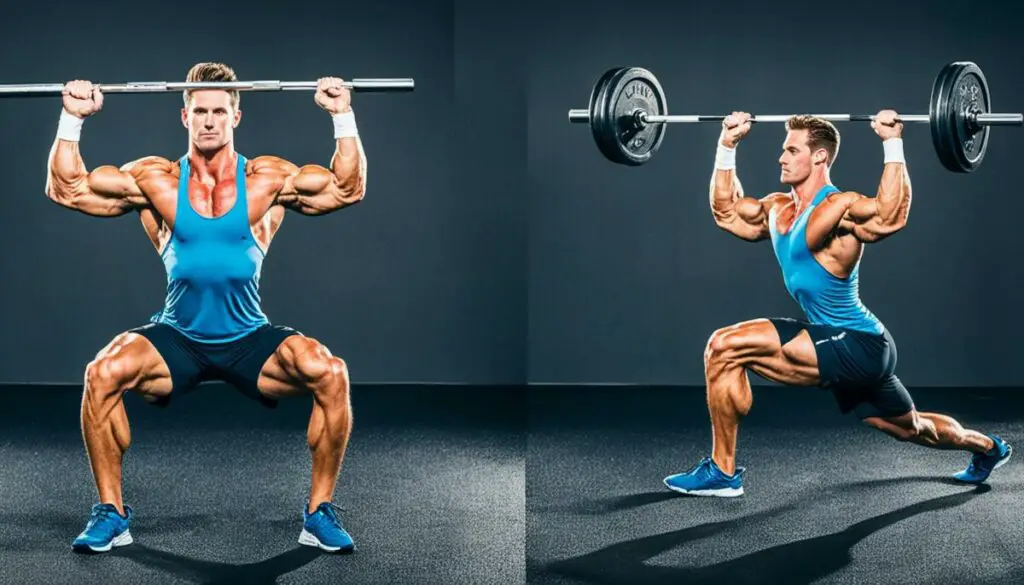
When it comes to athletes, the bar reverse lunge is a game-changer. This exercise offers specific benefits that can significantly enhance an athlete’s performance on the field.
The bar reverse lunge focuses on improving stability, power, and control through multi-planar movements. These are essential for athletes who rely on running, throwing, and swinging in their respective sports.
By mastering the bar reverse lunge and incorporating it into their training routine, athletes can develop the strength, speed, and explosiveness necessary for success.
Enhancing Stability and Control
The bar reverse lunge requires athletes to stabilize their bodies while performing the movement. This helps improve overall stability, which is crucial for executing precise and controlled actions during sports activities.
In addition, the bar reverse lunge engages multiple muscle groups simultaneously, forcing athletes to develop coordination and control through various planes of movement.
Building Power and Speed
Power and speed are essential attributes for athletes, and the bar reverse lunge can help develop both.
By working the muscles of the lower body, including the quadriceps, hamstrings, glutes, and calves, athletes can build the explosive strength needed for quick bursts of speed and power.
Optimizing Athletic Performance
Mastering the bar reverse lunge can have a significant impact on an athlete’s overall performance.
Whether it’s improving running speed, enhancing throwing accuracy, or generating more power in a swing, the bar reverse lunge trains the body to perform at its best on the field.
By incorporating the bar reverse lunge into their training routine, athletes can take their performance to the next level and gain a competitive edge.
So, if you’re an athlete looking to enhance your performance, don’t overlook the incredible benefits of the bar reverse lunge.
Differences between Reverse Lunge and Forward Lunge

When it comes to lunges, there are some important distinctions between the reverse lunge and the forward lunge. These two variations of the lunge exercise target different muscle groups and offer unique benefits for your lower body.
The Reverse Lunge:
The reverse lunge is often considered more beginner-friendly compared to the forward lunge. It requires less stability and control, making it a suitable starting point for individuals new to lunges. This variation also puts less stress on the knee joint, reducing the risk of injury.
One of the key benefits of the reverse lunge is its focus on activating the posterior chain muscles, including the glutes and hamstrings. By stepping backward, you engage these muscles to a greater extent, which can help improve strength and stability in the lower body.
The Forward Lunge:
The forward lunge, on the other hand, requires more stability and control. It involves the front leg as the main driver of force, placing a higher demand on the muscles of the quadriceps, hips, and calves. This variation challenges your balance and core stability, making it a more advanced exercise.
While the forward lunge may require more effort, it can also be highly effective in strengthening the muscles of the lower body and improving overall stability. It can help develop dynamic balance and coordination, which are essential for various athletic movements.
When incorporating lunges into your workout routine, it is essential to start with the reverse lunge and master the proper form before progressing to the forward lunge. This approach ensures that you build a solid foundation of strength and stability, reducing the risk of injury and maximizing the benefits of the exercise.
The Science Behind the Bar Reverse Lunge
Scientific research has shown that the bar reverse lunge is an efficient and effective exercise for improving leg strength, speed, and power. It helps recruit and strengthen specific muscle fibers responsible for explosive movements and speed. The unilateral nature of the reverse lunge also enhances balance, stability, and proprioception.
Studies have demonstrated that the reverse lunge can have similar gains in strength and speed compared to traditional bilateral exercises like the back squat. This means that the bar reverse lunge offers a viable alternative and can produce comparable results, especially for individuals who may have limitations or discomfort with squatting movements.
The bar reverse lunge is a versatile exercise, allowing for various modifications and progressions to match individual fitness levels and training goals. Whether you’re a beginner looking to build strength or an advanced athlete aiming to enhance explosive power, the bar reverse lunge can be tailored to suit your needs.
By incorporating the bar reverse lunge into your workout routine, you can unlock the full potential of your lower body. It provides a challenging stimulus to the muscles, promoting hypertrophy and strength development. Additionally, the continuous engagement of the core muscles contributes to improved stability and overall performance.
With proper technique and consistent training, the bar reverse lunge can be a game-changer for athletes and fitness enthusiasts alike. Its scientifically proven benefits and versatility make it a valuable addition to any lower-body workout routine.
| Benefits of the Bar Reverse Lunge | |
|---|---|
| 1. | Improves leg strength |
| 2. | Enhances speed and power |
| 3. | Recruits specific muscle fibers |
| 4. | Enhances balance and stability |
| 5. | Facilitates proprioception |
Incorporating the Bar Reverse Lunge into Your Workout Routine
To enhance your lower-body training, consider incorporating the bar reverse lunge into your workout routine. This exercise is an excellent way to strengthen your legs, improve stability, and target multiple muscle groups simultaneously. Follow these steps to integrate the bar reverse lunge effectively:
- Start with bodyweight reverse lunges: Begin by performing bodyweight reverse lunges to establish a foundation. This will help you focus on proper form and technique before adding weight.
- Gradually increase the weight: As you become more comfortable with the exercise, gradually add weight to challenge your muscles. This can be done by using a barbell or dumbbells.
- Include variations and progressions: To prevent plateaus and keep your workouts exciting, incorporate variations and progressions of the bar reverse lunge. Some examples include the walking bar reverse lunge, barbell front reverse lunge, and Bulgarian split squat.
- Aim for 2-3 sets of 8-12 repetitions: Perform 2-3 sets of 8-12 repetitions on each leg, with proper rest between sets. This will help build strength and endurance in your lower body.
- Combine with other lower-body exercises: To create a well-rounded workout, combine the bar reverse lunge with other lower-body exercises. This will ensure that you target all major muscle groups and achieve a balanced workout routine.
By following these steps and incorporating the bar reverse lunge into your workout routine, you can enhance your lower-body strength, stability, and overall fitness.
Example Lower-Body Workout Routine:
| Exercise | Sets x Reps |
|---|---|
| Bar Reverse Lunge | 3 x 10 (each leg) |
| Deadlift | 3 x 8 |
| Squat | 3 x 10 |
| Leg Press | 3 x 12 |
| Calf Raises | 3 x 15 |
Conclusion
The bar reverse lunge is a highly effective exercise for improving leg strength, stability, and power. By incorporating this exercise into your workout routine, you can target multiple muscle groups and enhance your overall lower-body training.
Whether you are an athlete aiming to improve your performance or a fitness enthusiast looking to build strength, the bar reverse lunge offers numerous benefits. Mastering the proper technique and gradually progressing with variations will help you maximize the advantages of this exercise.
Remember to focus on maintaining proper form throughout the movement, listening to your body, and consulting with a fitness professional if needed. By consistently incorporating the bar reverse lunge into your workouts, you can achieve greater leg strength, stability, and power.
FAQ
What are the benefits of the bar reverse lunge?
The bar reverse lunge strengthens the muscles of the lower body, improves core stability, hip mobility, and balance, and enhances leg strength and power.
How do I perform the bar reverse lunge with proper form?
Start by standing tall with feet hip-width apart and hold a barbell across your upper back. Take a step backward with one leg, bending both knees to lower your body toward the ground. Maintain an upright torso and push through the front foot to return to the starting position. Repeat on the other leg.
What are some variations of the bar reverse lunge?
Variations of the bar reverse lunge include the walking bar reverse lunge, barbell front reverse lunge, and Bulgarian split squat.
How should I progress and coach the bar reverse lunge?
Start with bodyweight reverse lunges and gradually add weight. Focus on establishing a strong foundation and perfecting the movement before progressing to more advanced variations. Use coaching techniques to ensure proper form and activation of targeted muscles.
What benefits does the bar reverse lunge offer for athletes?
The bar reverse lunge improves stability, power, and control through multi-planar movements, which are essential for running, throwing, and swinging.
What are the differences between the reverse lunge and forward lunge?
The reverse lunge is considered more beginner-friendly, puts less stress on the knee joint, and activates the posterior chain muscles. The forward lunge requires more stability and involves the front leg as the main driver of force.
What does the scientific research say about the bar reverse lunge?
Research shows that the bar reverse lunge is an efficient exercise for improving leg strength, speed, and power, with similar gains to traditional bilateral exercises. It also enhances balance, stability, and proprioception.
How can I incorporate the bar reverse lunge into my workout routine?
Begin with bodyweight reverse lunges and gradually increase weight. Include variations and perform 2-3 sets of 8-12 repetitions on each leg, with proper rest. Combine with other lower-body exercises for a well-rounded workout.
What is the conclusion on the bar reverse lunge?
The bar reverse lunge is a highly effective exercise for leg strength, stability, and power. It offers numerous benefits for athletes and fitness enthusiasts and should be incorporated into a well-rounded workout routine with proper form and progression.

